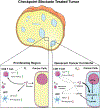Finding your niche: immune evasion in quiescent tumor reservoirs
- PMID: 35672237
- PMCID: PMC9674368
- DOI: 10.1016/j.it.2022.05.003
Finding your niche: immune evasion in quiescent tumor reservoirs
Abstract
Emerging immunotherapies offer a new hope for cancer patients but are not always effective even when a tumor is recognized by the immune system. Baldominos and colleagues address this challenge by characterizing a resilient niche of metabolically unique quiescent cancer cells (QCCs) that resist T cell-mediated control.
Copyright © 2022 Elsevier Ltd. All rights reserved.
Conflict of interest statement
Declaration of interests The authors declare no conflicts of interest.
Figures

Comment on
-
Quiescent cancer cells resist T cell attack by forming an immunosuppressive niche.Cell. 2022 May 12;185(10):1694-1708.e19. doi: 10.1016/j.cell.2022.03.033. Epub 2022 Apr 20. Cell. 2022. PMID: 35447074 Free PMC article.
References
-
- Emens LA, Goldstein LD, Schmid P, Rugo HS, Adams S, Barrios CH, Schneeweiss A, Dieras V, Iwata H, Chang C-W, et al.: The tumor microenvironment (TME) and atezolizumab + nab-paclitaxel (A+nP) activity in metastatic triple-negative breast cancer (mTNBC): IMpassion130. 10.1200/JCO20213915_suppl1006 2021, 39:1006–1006. - DOI

